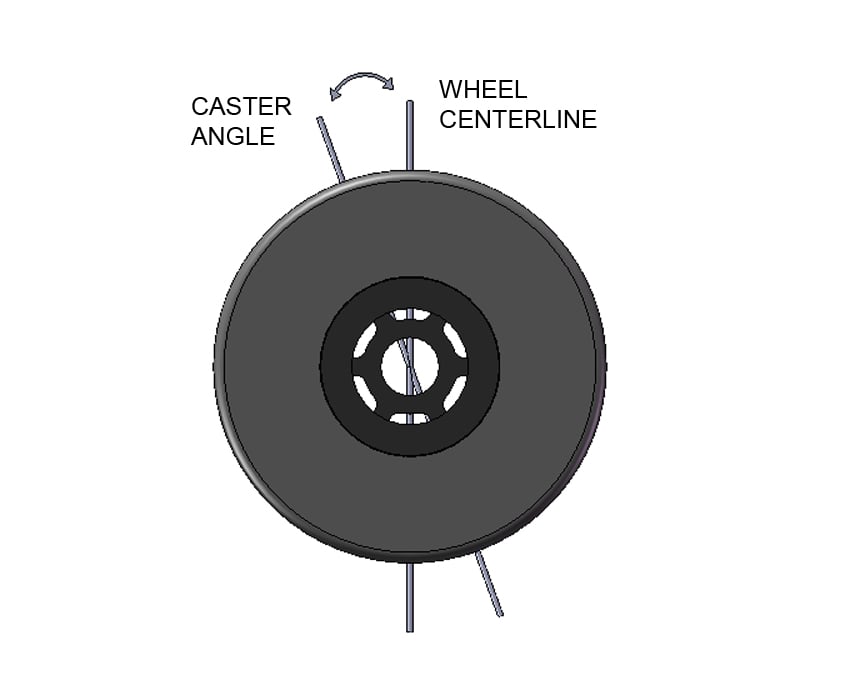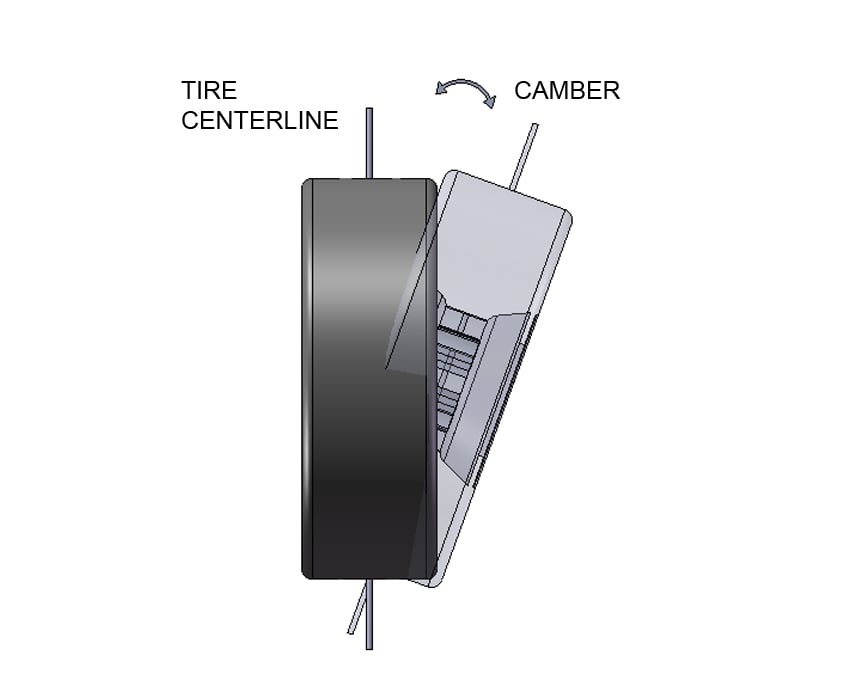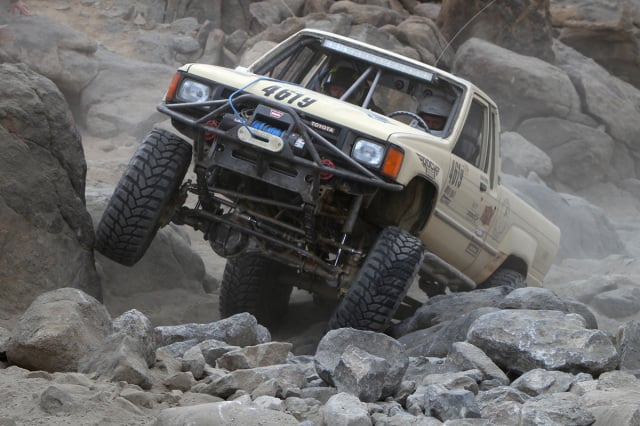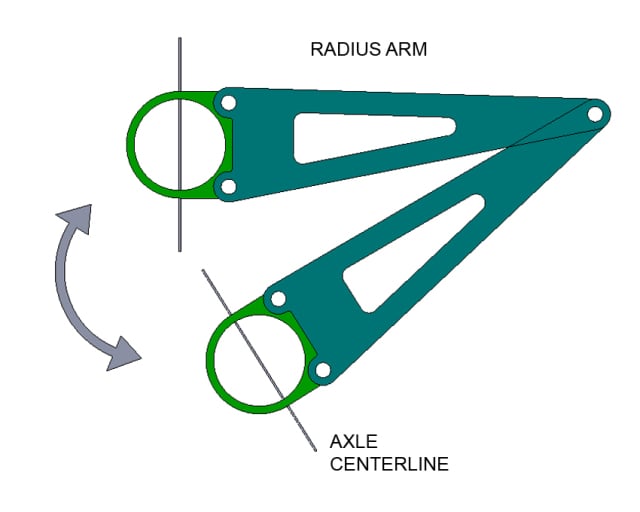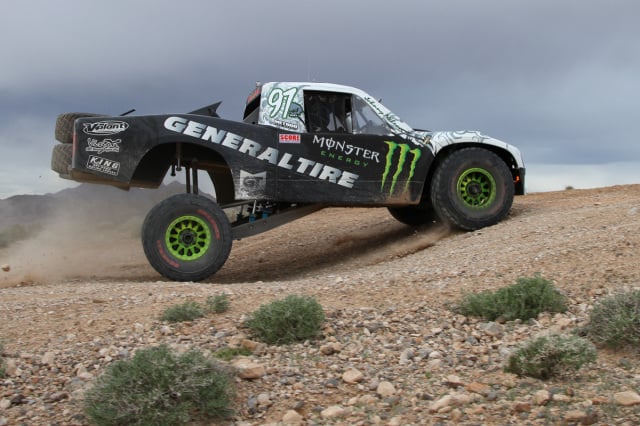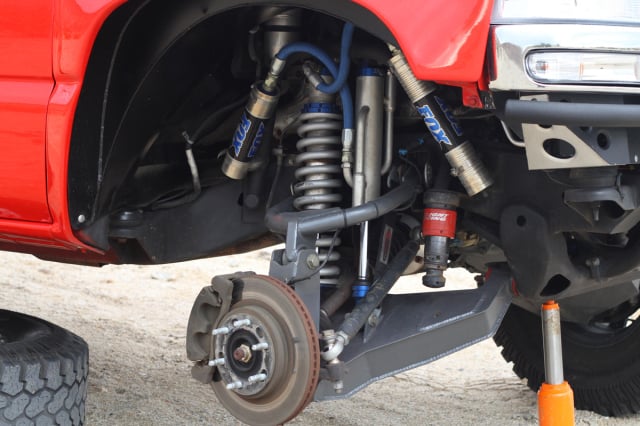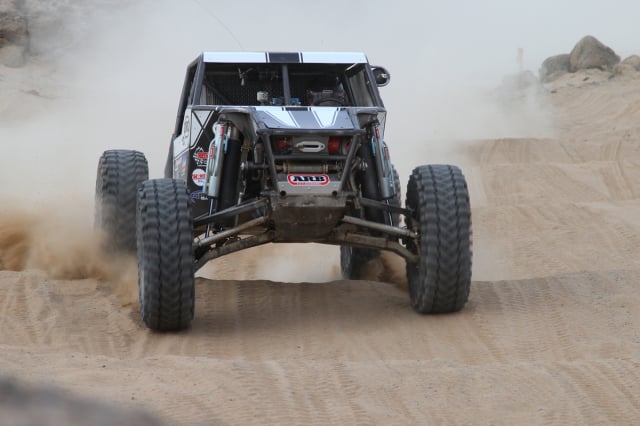When it comes to truck suspension, many four wheelers see it only as an instrument to fit the desired tire size they want under their truck. They are concerned only with lift, not function whereas engineers have much more to consider. “Packaging is a big factor,” says Craig Hall of Craig Hall Designs [1], “We look at the tire size, shocks, suspension travel needed and the working limits of the CV joints, spherical bearings, and other hardware. Once you factor in the limits of the hard parts you are using, the laws of physics will dictate what the final design becomes.”
The specialized off-road racing vehicles that Craig Hall creates may not look like your truck but they use the same basic suspensions designs found on production vehicles. In its most simple role, your suspension needs to hold your truck up and keep your tires planted on the ground. There are several ways to get that done but each has strengths and weaknesses.
You cannot compare factory suspension designs without talking a little about caster and camber. Caster angle is built into the front suspension so the steering is more stable and will return to center. Camber is the angle of the tire to the road – negative camber is when the tire leans in at the top and in contrast, positive camber is when the tire to leans out at the top, seen below.
Old Faithful, The Solid Axle
First let’s look at the solid axle. A solid axle is just that, an axle that runs from one side of the vehicle to the other. The entire axle moves as the suspension cycles. Simple and durable, the leaf spring/solid axle configuration has been used by most manufacturers for decades. It is still coveted by hardcore four wheelers.
The reason this design has survived for so long is because it does double duty as leaf springs suspend the vehicle and locate the axle. Attached solidly to the axle with U-bolts, the leaf springs run parallel to the frame. The springs are mounted to a solid perch on one end and a shackle that pivots on the other end. When the axle hits an obstacle, the leaf spring compresses getting flatter and longer, the shackle allows the spring to move without binding.
According to Fernando Gutierrez of Atlas Spring [5], “Most coil springs have a linear spring rate. Because of the leaf spring’s multi-leaf design, they have a progressive spring rate. The more they compress, the higher the spring rate rises. By varying their width, length, arch, thickness and number of leaves, they can suspend anything from a Suzuki Samurai to a cement truck. They work best with a shock that has the necessary damping to control the springs in rebound. Leaf springs are large and they need space to work. That’s why you see them used mostly in the rear and/or on larger trucks. Smaller more compact trucks and SUVs sometimes don’t have enough room to run leaf springs, especially in the front.”
Radius Arm Setup
Some solid axle designs use coil springs instead of leaf springs. Coil springs are more compact than leaf springs but they only support the vehicle’s weight; they cannot locate the axle like leaf springs do. The suspension members need to locate the axle while also allowing it to move. The radius arm design uses two arms that run parallel to the frame. They mount to a perch on the frame and solidly to the axle housing and allow the axle to pivot up and down. A track bar runs from the frame to the axle perpendicular to the radius arms to keep the axle centered on the frame. Since the radius arms are fixed at the axle end, the caster angle changes when the suspension cycles up and down, shown in the figure above. Radius arm designs have been used by Ford and Dodge among others.
Parallel and Triangulated Four-link
A variation on the radius arm suspension is the parallel four-link, shown in the figure above. Aftermarket manufacturers make kits that retrofit an existing radius arm suspension to a parallel four-link design and use coil springs and a track bar to center the axle. Instead of a radius arm with a fixed mount on the axle, it uses an upper and lower link on each side with pivots on both ends. As the axle cycles up and down, the links allow it to maintain the same relationship with the ground and the caster angle remains constant. Anytime you add a pivot, you add a wear item and the potential for deflection. What the parallel four-link gives up in strength compared to the radius arm, it makes up for in better ride quality and handling.
Another four-link design is the triangulated four-link. The parallel four-link needs a track bar to locate the axle side to side. With a triangulated four-link design, if the links are mounted at great enough angles, a track bar is not needed. When the top links are wider at the frame and narrow at the axle housing, then the lower links are mounted with opposing angles. The greater the angles, the more the links will resist side to side movement.
There is one more link type, solid axle design that is preferred by some of the most extraordinary trucks on the planet: Trophy Trucks. Trophy Trucks travel across the desert at speeds exceeding 130 mph. Running tires up to 42-inches tall, they have solid axles in the rear with trailing arms and a wishbone.
A Trophy Truck’s suspension is designed for maximum suspension travel and most are able to travel as much as 36 to 40-inches. Trophy Trucks are all custom-built from steel tubing; they do not have a frame, and the long, boxed construction trailing arms run parallel to the frame. The trailing arms attach low on the chassis in the front and to mounts below the axle housing at the opposite end through either spherical bearings or heim joints on each end. The wishbone is shaped like a “V” and the wide part of the “V” mounts higher to the chassis above the trailing arms whereas the narrow end attaches to the rear end housing with a single bolt.
Not only does it allow the rear end to travel freely up and down but the single pivot on the wishbone lets it articulate freely. Without the coilover shocks and huge, custom built, position sensitive bypass shocks mounted to the trailing arms, it would be very difficult to control the huge fabricated axle assembly and heavy bead lock wheels and tires.
Ford Twin Traction Beam
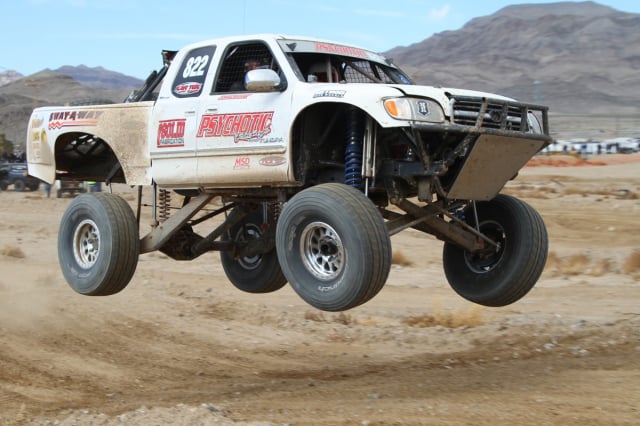 [9]
[9]This Toyota Tundra was retrofitted with an I-beam setup usually found on Fords. Notice the positive camber at full droop.
Ford has an independent suspension design that is part solid axle and part independent suspension – the Ford Twin Traction Beam or TTB. The TTB is similar to a solid axle except the drive axles and housing pivot in the center. It came from Ford with either leaf springs or coils. The two-wheel-drive version is called the twin I-beam. The TTB design works well as designed but has been maligned by many, usually due to modifications done by the end user. Complaints of unusual tire wear and bump steer are typical after installing a lift kit. Many times the culprit is the steering linkage, not the TTB design itself.
We talked to Geoff Falzone of Giant Motorsports [10] about the TTB design. “The biggest knock on the TTB design is how it looks when it cycles,” said Falzone. “It looks strange due to the camber change. Because it pivots in the center, the wheels swing on an arc that causes the camber to change. It may look strange, but TTB is very strong due to the length of the beams. It spreads the stresses out and has a much better shock ratio than A-arms.”
“The passenger side beam needs to be gusseted if you are doing a lot of off-roading,” continued Falzone. “It’s important to maintain the bushings and steering components on a TTB suspension. A lot of complaints about handling come from worn bushings.”
Fully Independent Suspension
Four wheel drive independent rear suspension is not widely used. Manufacturers have dabbled with the design but mostly to improve performance on the pavement, not in the dirt. Production trucks have to transport people, carry cargo, tow trailers, and meet cost constraints so simpler is better to most manufacturers. Rear engine desert racing vehicles use an independent rear design using a single trailing arm on each side. In order to keep everything compact, they run a transaxle mounted directly to the engine transmission. While they are independently suspended, they are specially built for racing and only two wheel drive.
Four wheel drive independent suspension in the front is very common and has been in use for decades because it provides better ride comfort and is much more compact. Struts, coils, and torsion bars are all used to suspend the vehicle on this suspension type depending on application. On smaller trucks, the axles are pushed farther forward; there is little room left for leaf springs. The most common independent suspension design up front is unequal length A-arms. Two arms mounted perpendicular to the frame attach to an upright that holds the hub assembly. Both arms pivot at both ends but the top arm is usually shorter than the bottom arm to keep the tire parallel to the ground as it cycles up and down through the range of travel. The A-arm design keeps the caster angle consistent and the camber where it needs to be during the full range of motion.
The compact nature of the design is good for packaging but the downside is that it gets crowded. The drive axle, steering linkage, shock, and spring all fight to occupy the same small space. When A-arm suspension first appeared, it offered a new challenge to aftermarket suspension companies because there were no simple ways to lift the vehicle more than an inch or two. They designed drop brackets that moved the suspension mounting points farther from the frame but they did nothing to improve the strength or performance of the factory design. This prompted several niche manufacturers to build custom long travel suspension systems that use technology developed in off-road racing. Longer and stronger arms, beefy attachment hardware, and state of the art shocks give huge performance gains over the factory set-up. Will all of their complexity, A-arms are considered to be more expensive to get large amounts of travel whereas a TTB setup allows you to get a decent amount of travel for relatively less money.
One such company that took their racing technology to the streets is Brenthel Industries [13]. Their “Baja Kits” suspension systems allow you to bolt on race quality parts to your factory suspension mounts. Brenthel builds kits and they also design and manufacture race vehicles that compete from Baja to Dakar. Their racing experience helps when it comes time to design their Baja Kits. [14]
[14]
“The rear straight axle and four-links on our race vehicles are very stout,” said Jordan Brenthel of Brenthel Industries. “The front end takes more hits and has less travel, it is more likely to suffer damage and wears faster than the rear when you are pushing hard. Independent suspension with long travel and four wheel drive gives you a comfortable ride with the ability to absorb the bumps at speed. The traction you need for slow speeds or deep silt and sand is there when you need it. It’s the best of both worlds.”
Brenthel may have his mind made up as to what the best four wheel drive suspension design is but the debate rages on in the Ultra4 [15] racing series. Ultra4 started on a bet when 13 rock crawlers met on a dry lake bed in 2007 to see if they could run all the hammers trails in Johnson Valley in a single day. They did it and from that day on they would be the O.G. 13. Their challenge turned into a full blown race, the King of the Hammers (KOH), and now spawned a national series. King of the Hammers combines the high speeds of desert racing with some of the most challenging rock climbing trails in the country and is considered to be one of the toughest motorsports events on the planet. The first few years, there were many production based vehicles in the field. Competitors are now building innovative tube framed beasts for the race, filled with custom made components. In only seven years, the King of the Hammers race has become a major driver of four by four technology.
King of the Hammers Suspensions
Every year, there is an ongoing debate at KOH as to which suspension design will be superior; straight axle or independent. Independent reigns supreme in the open desert whereas the straight axle rules the rocks according to some. Shannon Campbell, a two-time King of the Hammers, prefers the independent design. “Independent doesn’t beat you up,” said Shannon. “At KOH there are so many whoops, (the endless choppy bumps formed in the dirt), the independent suspension is so much better at speed. I’ve owned both types of cars; the solid axle is simple and reliable but independent goes just as good in the rocks. When it comes to speed and drivability, independent is better.”
Loren Healy has also been crowned the King of the Hammers two times and both times he was driving a straight axle car. “We won the Hammers race twice with a straight axle car,” said Healy. “I prefer a straight axle in the rocks. You get much more steering angle and you don’t have to beat the car on the rocks. With a straight axle, one tire can lift the entire front end of the car. An independent front will just flex the suspension on one side. You really have to keep the tires on top of the rocks with A-arms. With a solid axle you don’t have to be so precise.” Healy just built an A-arm car and won four straight races with it. “Our new car is very fast but the races we won didn’t have the huge rocks KOH has. We are going to give the A-arm car a shot at KOH this year just to see how it does.”
The debate between the independent suspensions versus the straight axle crowd will probably never be settled. Both designs are proven capable off-road. Independent is more comfortable at speed but with it comes complexity. The solid axle may not ride the best, but the simple durable design shines when things get tough. The TTB falls somewhere in between and does allow the pre runner crowd to get more travel for less money when compared to A-arms.
Let us know what type of suspension you prefer in the comment section below and if you want to see more in-depth suspension related articles, let us know!
